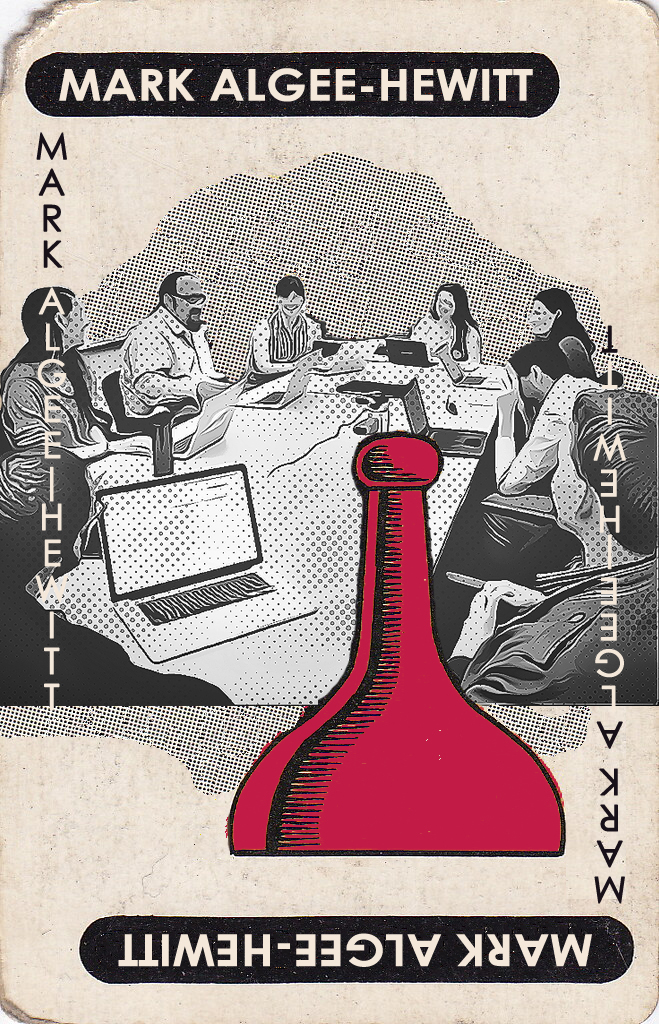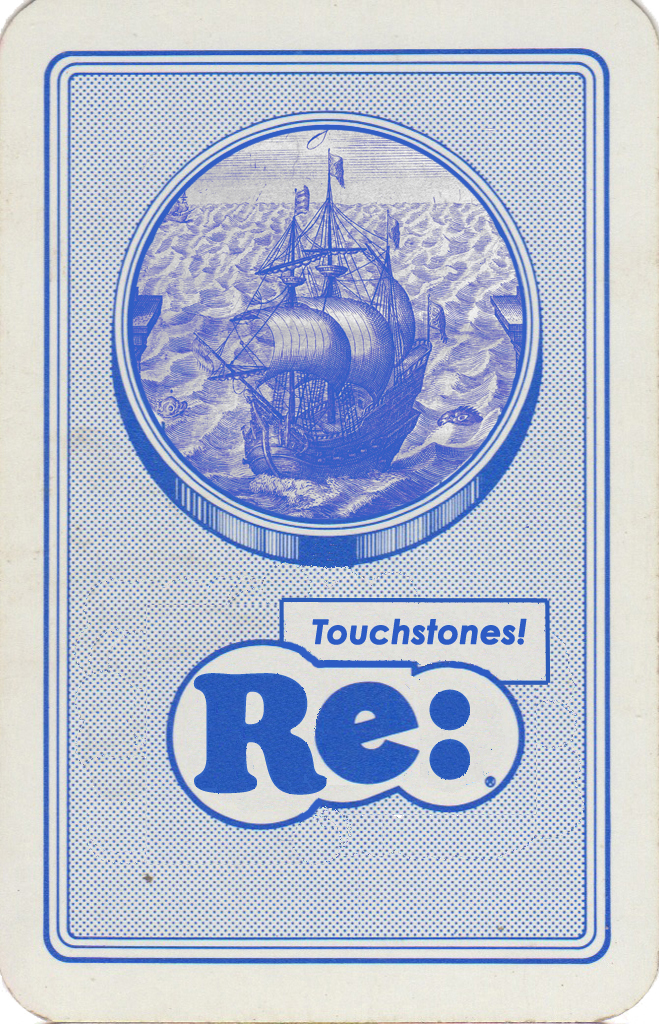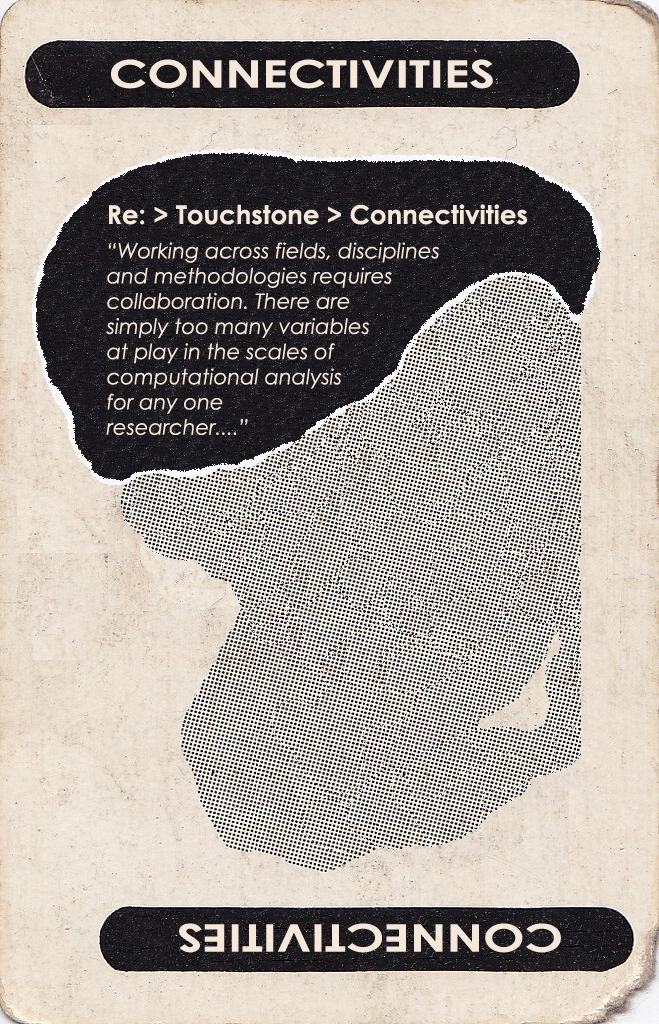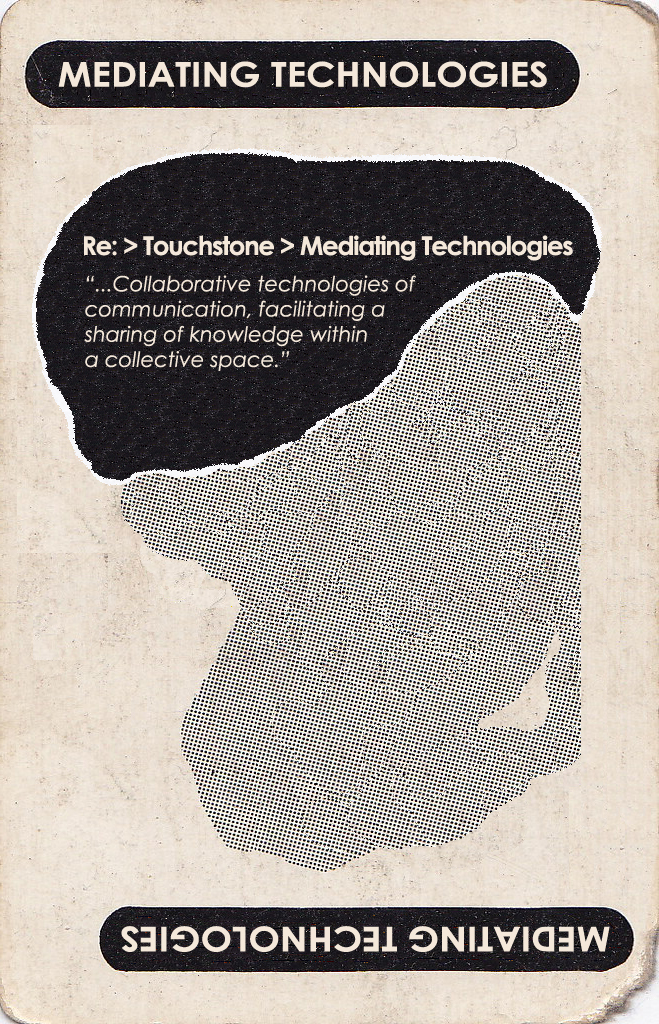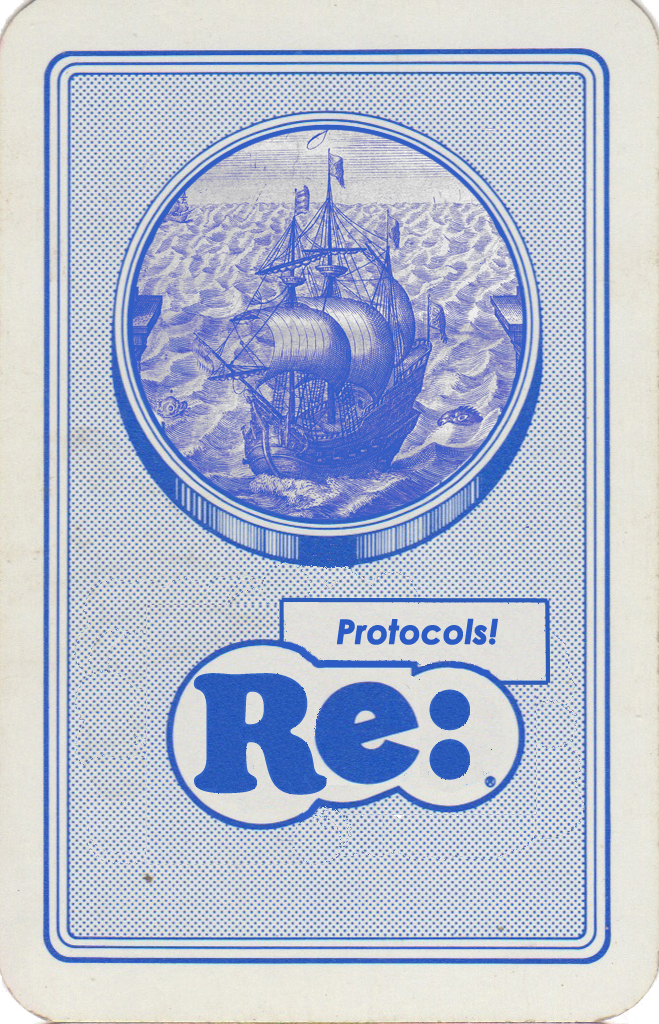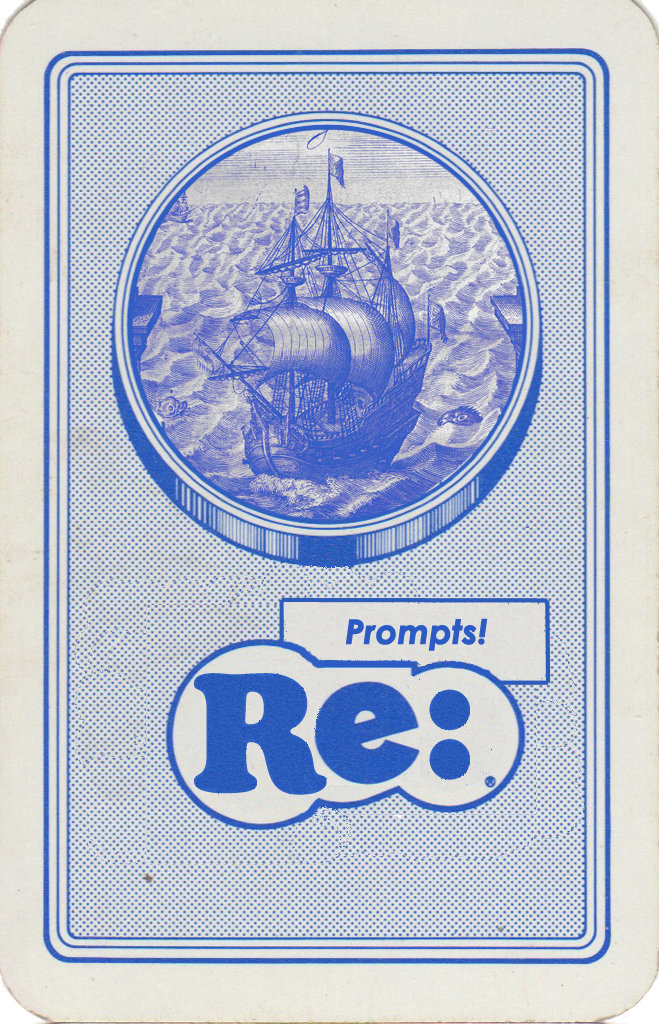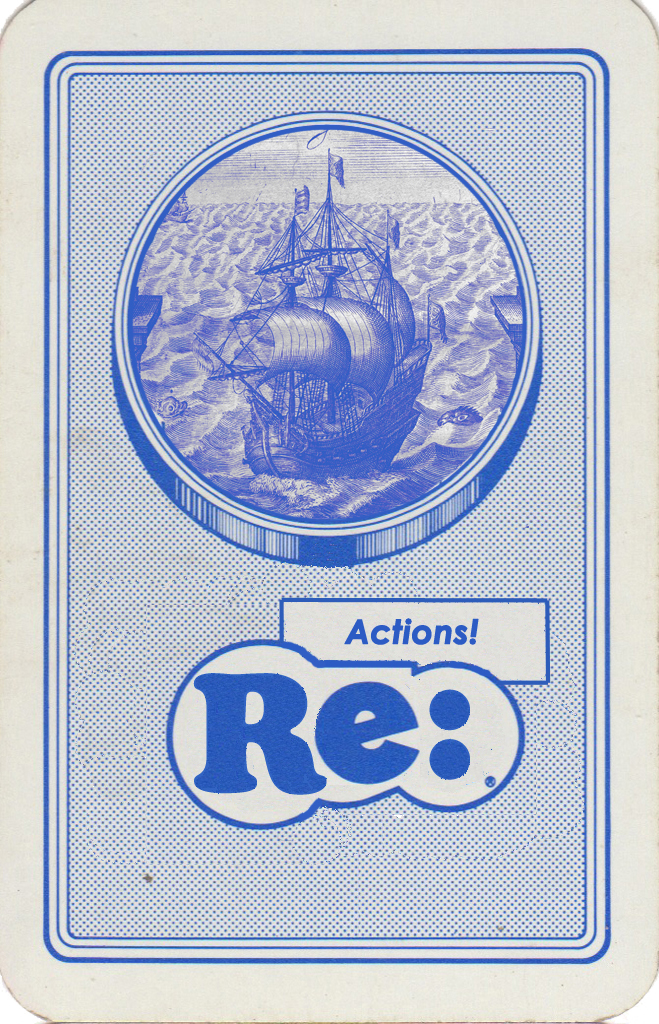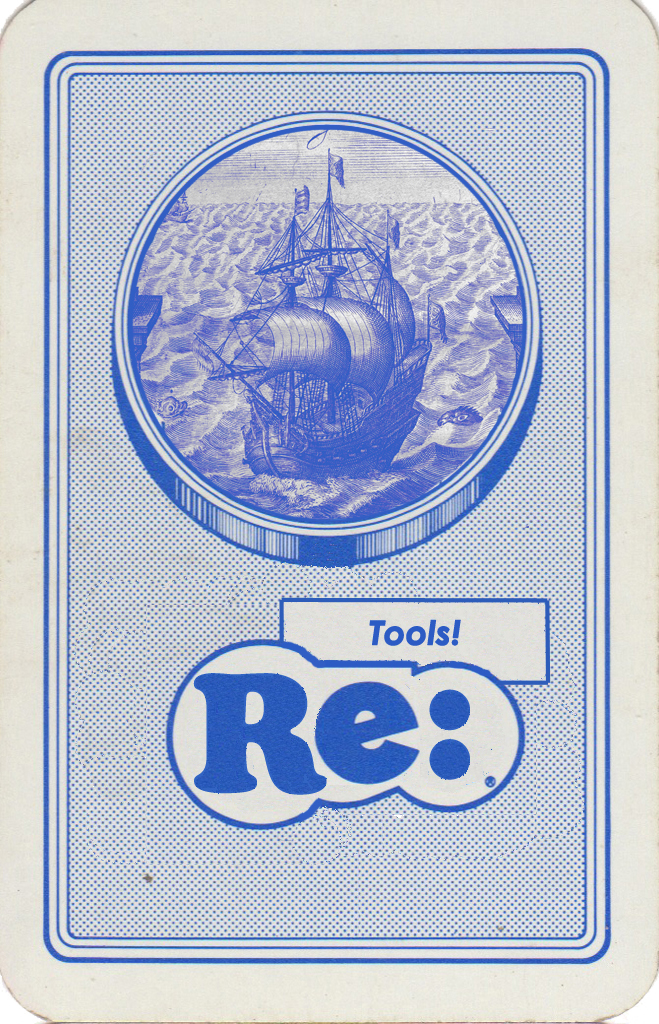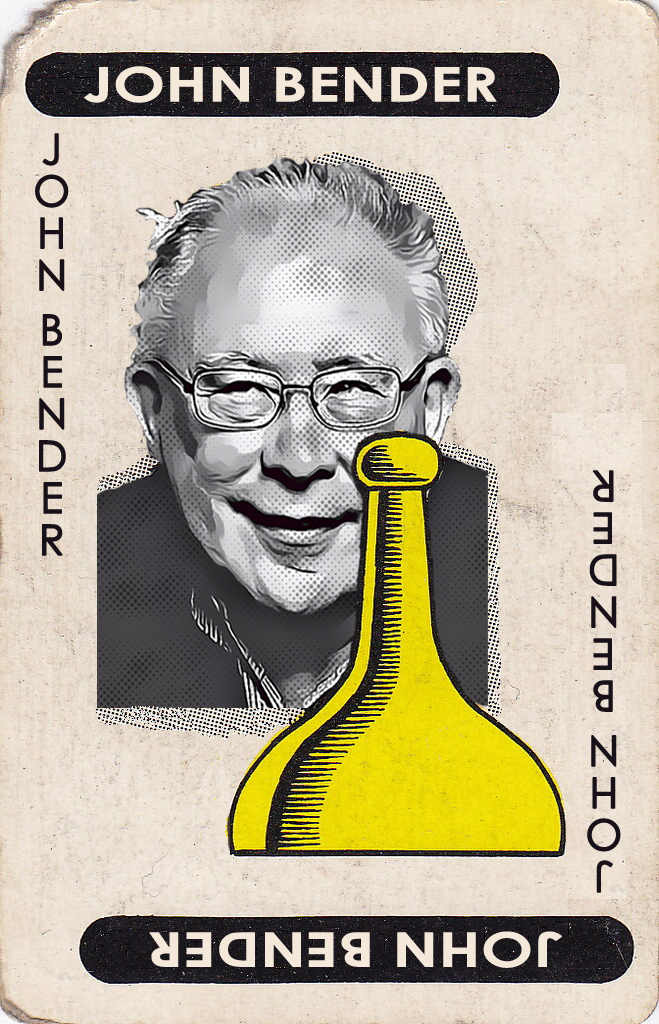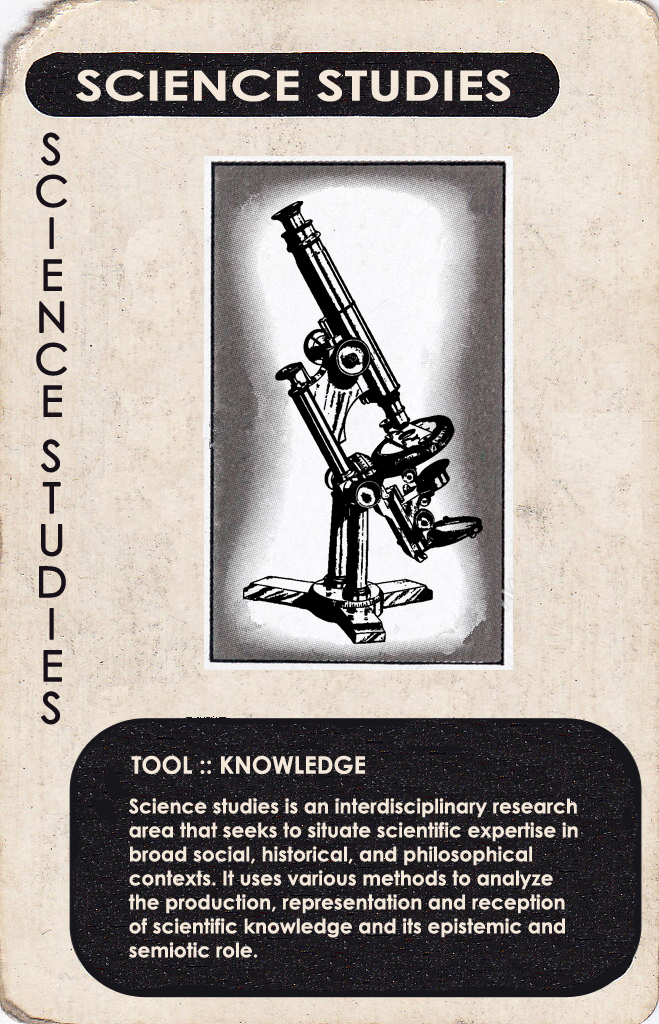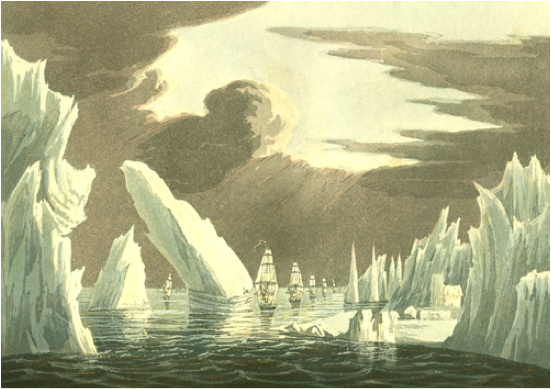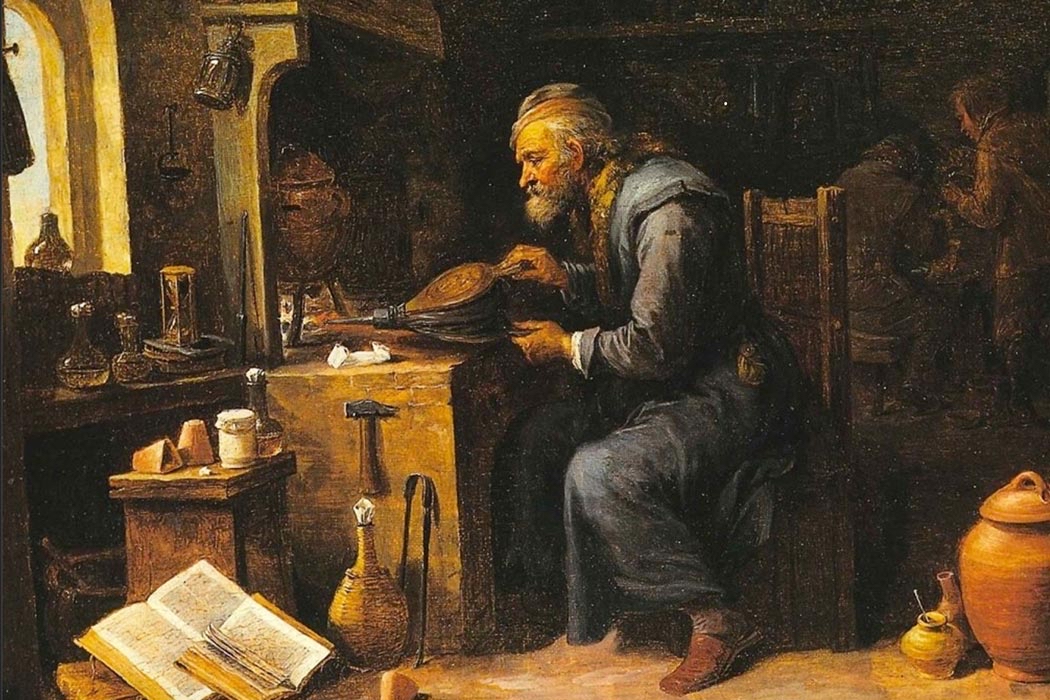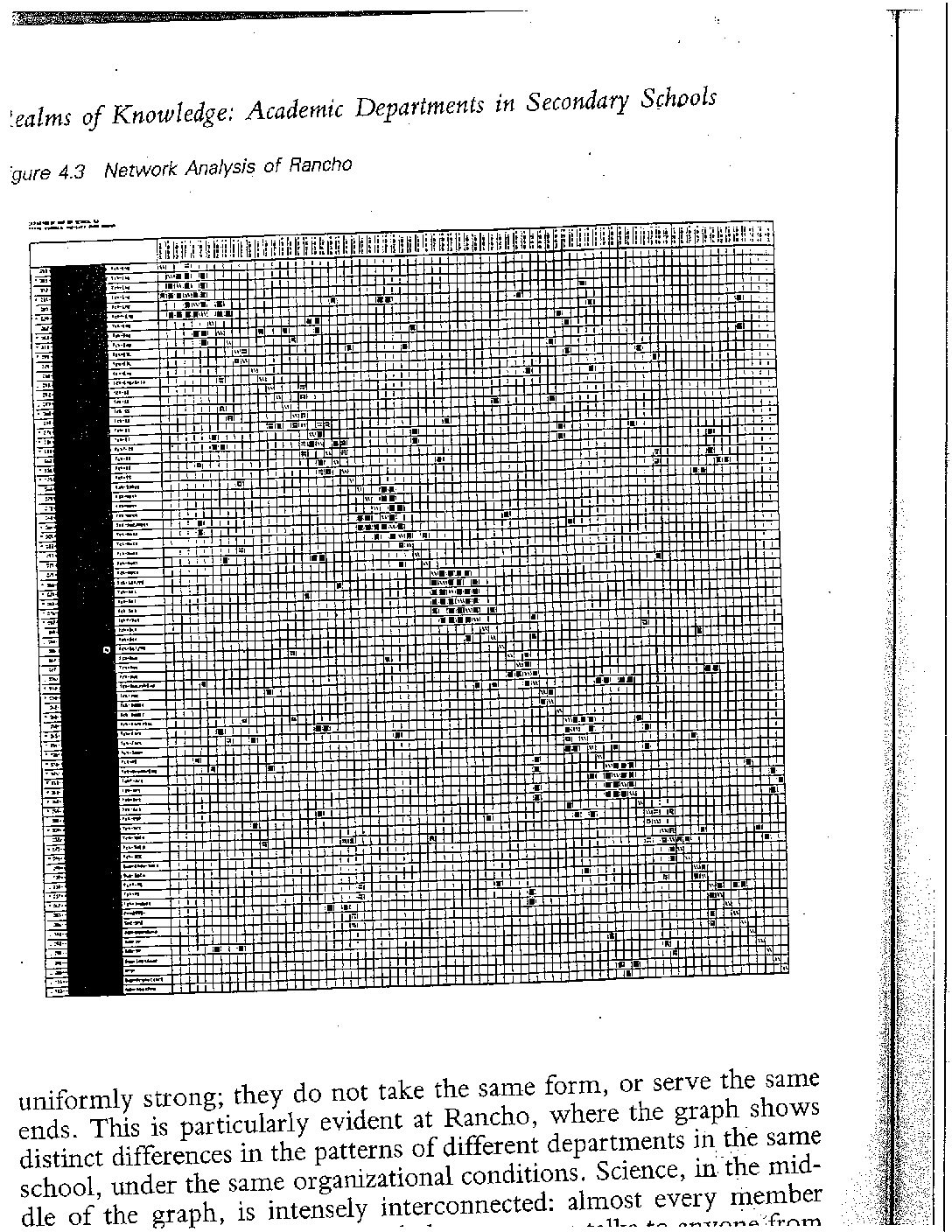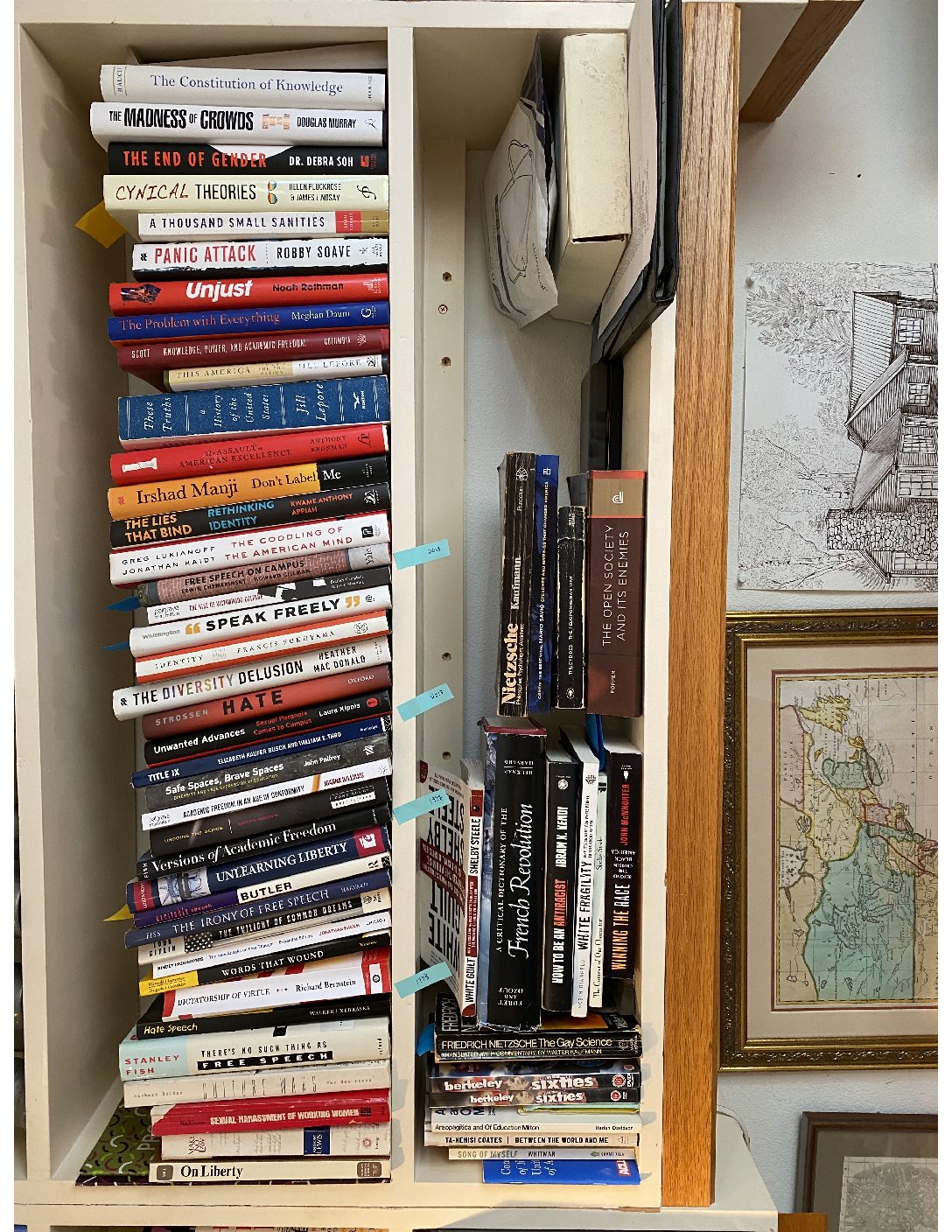A primary aim of the Re:Enlightenment Project is to model and test alternative accounts of the field of knowledge as a whole, its mediations and hierarchies, in order to provide possible new ways forward. Think of it this way: doing knowledge work in a Re:Enlightenment mode means putting all of our pieces on the board and working with the cards we are dealt; or, sometimes, needing to deal ourselves a new hand. The pieces (actors), the board (institutions, practices, traditions, lineages), and the cards (the protocols, prompts, modalities, touchstones, and prompts that enable–or sometimes disable–what is and can be understood as knowledge from wherever it is positioned)–this is what makes up what we call “the siting of knowledge.”
To recognize all knowledge as sited knowledge is to recast our understanding of how knowledge works in the world—of how the field of knowledge consists not just of different kinds but also of manifold nodes and clusters of sites for both knowledge and knowing. Each of our “Workshops,” accordingly, are made up of specific practices within specific locales. By “putting our cards on the table,” we seek to bring into the open the protocols and tools that enable our own movements along and across the complex, multitiered game-board that is sited knowledge.
- Mark Algee-Hewitt
- Dorian Bandy
- John Bender
- PETER DE BOLLA
- Geof Bowker
- Johanna Drucker
- AARON HANLON
- Ryan Heuser
- Mike Hill
- Yohei Igarashi
- TONY JARRELLS
- HELGE JORDHEIM
- Paul Nulty
- Murray Pittock
- JOHN REGAN
- Seth Rudy
- LESLIE SANTEE SISKIN
- Debapriya Sarkar
- John Seberger
- CLIFFORD SISKIN
- Kim Sloan
- Bill Warner
- Gretchen Woertendyke
MARK ALGEE-HEWITT’S Workshop
Since I have a physical workshop, I thought that I would include an actual snapshot of it. This is the Stanford Literary Lab: depending on how you feel about the place of computation in the humanities, the place where the magic happens and/or the sausage gets made. While, during the past year, the work of the Lab has continued despite our absence from the workshop, the photo of the space itself illustrates a few important technologies that underlie the work that I do and the business of creating knowledge in the lab.
1. Embodiment
The Literary Lab is a real place (room 401 in Margaret Jacks Hall on Stanford’s campus). When I’ve consulted with other institutions on setting up their own Digital Humanities centers, I’ve always underscored the importance of physical space in their designs.
While it would seem that the last year (during which time the Literary Lab has been as active as always while the room itself has remained closed) might prove the obsolescence of the need for dedicated research space, the opposite is true. Our “windowless room” has served as an anchor point for the research group, creating a sense of collective identity that has material attachments and, with them, a kind of permanency. While our conversations have been facilitated by zoom (and other distanced technologies), the effects of inhabiting the same space, where often someone would overhear a snippet of conversation, get interested and make a suggestion, join a project or even suggest a new research direction entirely, do not translate to a medium where all interactions are pre-scheduled.
2. Collaboration
Working across fields, disciplines and methodologies requires collaboration. There are simply too many variables at play in the scales of computational analysis for any one researcher, except in exceptional circumstances, to do all of the work on their own. The business of the Lab involves conversation, discussion, even argument as the different parts of projects are hashed out. It needs a generosity of spirit and an admission from all members of the project that their preconceived ideas may not be shared by all members of the group. Not just in terms of the research material itself (the data, methods or conclusions), but, as we collaborate across fields, an understanding of the different needs of members from different disciplines or institutions. There is a reason that the Literary Lab is dominated by a table where all of the chairs face the center: even when one member, or a group, are presenting their findings, the mode of engagement is still discussion, rather than a lecture or seminar.
3. Visualization
The two pieces of permanent material technology visible in the snapshot are both engineered for visualization: the screen on one wall, and the whiteboard on the other. While much of the computational work goes on behind the scenes (and behind the screens) of each member’s individual devices, these two pieces of technology bookend the ways that our projects produce knowledge. Both, again, are collaborative technologies of communication, facilitating a sharing of knowledge within a collective space. The white board offers a medium for sketching out ideas (often literally), writing down plans, taking notes, and assigning tasks. This is the work of beginning a project and inscribing these elements on a publicly visible space not only facilitates the full participation of all members, but also makes what we’re doing visible to people who are not members of the project (but who, in the kind of serendipity that I describe above, often become members once they see what we are working on). The screen is necessary at the other end: when we have done the computational work and need to share it with the rest of the project’s collaborators (or members of the lab at large) the large-format screen allows us to project, manipulate, and, above all, communicate the results of our analyses in a way that engages all of the members in the room. Simply sharing images across computers by e-mail or drive erects various barriers, both technological and intellectual: by projecting results on the screen within the context of a collaborative meeting, we can discuss what we’ve done and what we need to do in an inclusive and participatory way. (Not visible is the projector that casts the image of the screen onto the whiteboard where we can interact with it: as it turns out, the two processes are far less compatible than we had anticipated when we installed this technology).
The Literary Lab is a node in a dynamic network of knowledge production: one where different subjects, ideas and fields flow in and out mediated by the methodological concerns that we share as members. Whether scaling up the kind of project that Seth has done with his work on the Cyclopedia to think through our nascent collaboration on encyclopedic thinking, or beginning with a large corpus on climate change and scaling down to the minutia of the relationships between fictional and “real” knowledge as in the collaboration between Aaron, Yohei, Mike and I, the Lab serves as a crucial node in the infrastructure of knowledge production within my field, and in my work as a whole.
Dorian Bandy’S Workshop
My knowledge-work is focused both on the very specific and the very abstract.
As a musicologist, and as a lover of artworks more generally, my goal at all times is to explain why and in what way I adore certain works of art. This goal—of communicating a love of beautiful artworks—unifies everything I have written. I imagine that it will continue to do so for the foreseeable future. I am constantly trying to say how I approach (for instance) a particular Mozart concerto or Beethoven sonata, what I hear in it, and why I find it meaningful. If I can do so with sufficient mastery of the professionalized machinery of academic writing—respectable citations, etc—to get my writing through peer review, then so much the better.
But publication and peer-review are secondary goals in my workshop. In this sense, my work is tirelessly and unabashedly centered on the specific: I want to understand that particular turn of melody within that slow movement, celebrating the peculiar allure of that concerto. All of this is to say that, in my heart, I am just a “New” New Critic, excited by close readings and living on the inside of artworks.
At the same time, and alongside this obsession with the specific, my philosophical and epistemological commitments force me constantly to engage with broad abstractions. As everyone here knows all too well by now, I believe in the absolute necessity of taking explanations seriously, and this means recognizing that underlying explanations, though often tacit, exert a strong pull on what we observe and how we observe it. As Popper puts it in The Logic of Scientific Discovery (p.36), “observation is always observation in light of theories.” A number of points follow from this idea. The first point is that my close-readings are results of general theories I hold about art, science, culture, knowledge, and all other aspects of the world. In a sense, therefore, the subject of my work is ultimately those theories, rather than any individual artwork. If a colleague takes issue with my analysis of a Mozart sonata, I am aware, even if the colleague usually is not, that what is at stake is not the minutiae of musical structure in that one sonata, but rather the entire worldview that has led me to approach the sonata in the light that I have. A second point is that virtually all of my work, regardless of the specific musical works under examination, ends up more or less explicitly discussing these fundamental explanations and theories. Because I believe so strongly that underlying theories dictate how I engage with artworks, it follows that I should expend considerable thought on how and why I hold those theories, since the cost of error is enormously high. This is not to say that an error-free theory is available to me even in principle; there will always be room for improvement—a point of profound optimism! But although all of our theories are shot through with errors, some errors are worse than others, and my interest in epistemology arises in part from a desire to adopt the best theories available, to whatever extent I can. Of course, this entails a further epistemological need: not only an awareness of the role of theories in making observations, but a theory about theories: some set of criteria for what makes some explanations better than others. A large portion of my recently-finished book on Mozart is addressed to precisely this question, trying to untangle why one theory of Mozart might be preferable to another. This obsession lurks behind everything I do.
In terms of the nature of my workshop itself, these are some of the tools I bring to bear on any ideas and projects I pursue:
- Explanation. The importance of explanations has already been the subject of my previous posts and discussions, so I won’t rehash those ideas. I’ll simply say here that I always try to understand why something is the case, rather than simply that it is the case. In my broad, philosophical commitments, this means, for instance, asking why one theory is preferable to another. In the division of my workshop focused more minutely on musical analysis, this means, for instance, asking why Mozart may have selected one note rather than the other—and this in turn calls up a long series of questions pointing ever deeper into the realm of abstraction. For instance, it forces me to become comfortable with…
- Invisibility. Explanations necessarily account for the seen in terms of the unseen. Both Newtonian mechanics and general relativity try to account for the phenomenon of gravitation (i.e. why apples fall from trees). The difference between the two theories lies in their accounts of invisible processes that cause observed phenomenon. The curved spacetime posited by Einstein is invisible in principle; we can observe only its effects on physical matter. So too are Mozart’s thoughts, and so too are the aesthetic criteria that gave rise to his musical output. So, too, are explanations themselves, which are abstract ideas. This may seem obvious, but most work I encounter in various fields wrongly fetishizes data, evidence, and observation, and misses the mark on countless fundamental issues as a result. The antidote: become comfortable with ideas and explanations that cannot be observed, yet which can be the subjects of criticism and conjecture.
- Conservatism. Time is limited, and most ideas, explanations, and artworks (and countless other things too!) are simply bad. There are infinitely more ways to be wrong than right, and this means that an explanation that is even partly successful is a precious thing, to be held and cherished until a better explanation is discovered.
- The source of an idea is unimportant. Although in my “real life” I value other people greatly, in my intellectual workshop nothing matters but ideas. I strive to understand ideas in principle—their structure, their meaning, their implications—without getting into tangles over historical meanings, original usage of terms, the identity of those who originated the idea, and the like. For instance: empiricism is false; the structure of the idea that “knowledge is derived from observational data” is logically incoherent. It doesn’t matter that the term was in use in the 18th century; nor does it matter that many scientists and philosophers of the past 400 years have believed that they were deriving knowledge from experience. They were all simply wrong about the actual nature of their work. Understanding ideas without regard for their source makes it possible to pursue better and better explanations. Conjectures and refutations alike can come from any source, and can take any form.
- Gratitude. Most of all, my workshop is based around gratitude for the precious traditions and institutions—intellectual, artistic, aesthetic, cultural—we have inherited. Part of my purpose in my work is to understand those traditions, and to capture, through my explanatory investigations, why they are so wonderful. Part of what has kept my intellectual commitments on-track and stable over the past year of social unrest and calls to rethink our artistic canons and curricula is the conviction that, despite the flaws our institutions and Western societies have still not quite ironed out, we are indescribably lucky to live where and when we do. In my own fields of musicology and music theory, many colleagues have spent the last year calling to strip Beethoven from concert programs and university curricula because of his alleged white supremacy. Aside from the demonstrable, flat-out, grinding wrongness of the idea that Beethoven’s music is in any way entangled with white supremacy, the very call is itself nihilistic. Beethoven created some extraordinarily beautiful music, and we are all lucky to be alive at a time when we can hear his music at the click of a button. I shudder to imagine how impoverished the life of any great 18th-century thinkers on art must have been for their not having lived to hear a Beethoven piano sonata. If we are all united in our infinite error, this assessment includes Beethoven, it includes the anti-Beethoven woke folk, and it includes me. It is trivially easy to call out wrongness and imperfection. But what matters ultimately if we hope to live in an even better world is to understand the many things that Beethoven—as well as other unjustly-vilified visionaries like Adam Smith (to name just one)—got right. We should try to lay bare their insights and explanations and incrementally improve on them, rather than cynically tearing them down.
John Bender’S Workshop
Many of the tools in my workshop date back to my undergradaute and graduate education in literature and art history. My dissertation and first book were on literary pictorialism. My book Imagining the Penitentiary is shot through with high and popular imagery, with most of a chapter on Hogarth. The Stanford Seminar on Intrepretation, which ran weekly for six years, brought me into the worlds of high cultural theory and philosophy.
Along the way, I added science studies, with the publication of an essay on fiction in early science and in the novel. These strands braided together in my 2010 book The Culture of Diagram, co-authored with art historian Michael Marrinan. The work focuses largely on French material, as does my essay on rational choice theory and the novel Les Liaisons Dangereuses. I took a hands-on course in human anatomy along the way, and have paid attention to film studies. My most recent publication is on sound effects in Horace Wapole’s novel the Castle of Otranto, using the category of Foley effects from film.
PETE DE BOLLA’S Workshop
This invitation was in part prompted by Lisa’s account of her working in a ‘workshop’ and as I began to think about how to respond to the invitation I called to mind the fact that over my working career I have had the great privilege of working in many kinds of ‘workshop’ with many extremely thoughtful and knowledgeable people. The names that I and we used for these ‘workshops’ are various and include: ‘Lab’, ‘seminar’, ‘reading group’, ‘class’, ‘conference panel’, ‘exchange’, ‘discussion group’. All these ‘workshops’ had specific aims and objectives in mind, and some were more successful in realising them, but the thing they have in common is that they all included others, other minds. It is clear that behind the invitation a slightly different conception of the ‘workshop’ lurks – in essence the invitation is to peer inside oneself, as if I might constitute a ‘workshop’ for and of myself. In terms of my working hypothesis about ‘knowledge’ this model is incoherent, since as the four terms in the second part of our prompt make clear, ‘knowledge’ is imbricated within all four – let us call them instantiations – which necessitates that whatever this ‘knowledge’ might be it must be a common property, that is commonly produced, disseminated, accredited and curated. Another of Re:En’s working hypotheses, namely that ‘knowledge’, for it to be ‘knowledge’, is necessarily sited shares a similar conceptual architecture.
It seems important to me that these two observations are not taken to imply or support the mistaken thesis that ‘knowledge’ is relative, that is relative to where the claimant and claim to ‘knowledge’ is sited, that is where such claims are entered, as it is also important to me that one mistaken understanding of the observation that all ‘knowledge’ is sited, which is to say the assumption that this indicates that all ‘knowledge is relative’ to other, different ‘knowledge’ should be exposed. To make this clearer: ‘Knowledge’, under the rubric which gives me access to my understanding of in what it consists, namely the condition of possibility for any ‘knowledge’ is that is it sited, does not lead to the conclusion that one form or type or instantiation of ‘knowledge’ is relative – and therefore only weakly true, or true only and on account of desiderata that are not epistemic – to any other forms, types or instantiations. Such an account of ‘knowledge’, which I see as infected by an unreflective imposition of individualism within a consumerist ideology onto the domain of epistemology, misunderstands what is at stake – and therefore the condition of possibility – in the claim that all ‘knowledge is sited’. Such a claim entails that ‘knowledge’ to be recognised as ‘knowledge’ must have a site, a location which determines that from here, this place, this is ‘knowledge’. There is no other place, no relative position which could make a different claim to what this sited ‘knowledge’ recognises as ‘knowledge’. Being positioned thus is not simply a matter of location: it encompasses modes of enquiry and legitimation, institutions, media, practices and traditions, all of which are subject to evolution, decomposition, revision and critique. It rests upon the obligation to make the case for this ‘knowledge’ to be the best claim that can be made in and from this place. This is sometimes called the best fit to the evidence.
In our discussions most recently something akin, perhaps, to these reflections has surfaced, but on occasion during the imperfect medium of the zoom conversation I have worried that a residual mistaken thesis about ‘knowledge’ and its relativism has begun to surface, or support claims that there are ‘different ways of knowing’. At least on one, perhaps imperfect reading, such claims have appeared to me to disinvest in the concept ‘knowledge’ itself, as if a solution to a sometimes perplexingly difficult question, as to what ‘knowledge’ consists in, can be found in the flight to politely agreeing that there are many, perhaps very many, as many are there are persons, ‘ways of knowing’. At the very least, it seems to me, one might want to ask politely what such different ‘ways of knowing’ might be and whether such ‘ways’ are substitutes for or representations of, or even rejections of ‘knowledge’ (as I have outlined it above). I make these observations in full awareness of the fact that I wrote an entire book about the work of art as a ‘way of knowing’, which is to indicate that I am not simply rejecting the notion out of hand.
Over the last ten or so years I have been using a kind of placeholder term, what I call the ‘common unshareable’ as a ‘tool’ for understanding many of the things/ideas I have been moved to become curious about – and that curiosity has certainly been motivated by my sense that ‘we’ have imperfect understanding of such things/ideas. Among these are aesthetic experience (and indeed if there is such a category), ‘concepts’ as road maps or even ‘protocols’ for arriving at understanding, and under the rubric outlined above ‘knowledge’. When thinking about these things I often find myself gravitating toward this structure of understanding – it helps me see better what is at stake in my trying to arrive at what, for now, seems to be the best formulation of what I take to be ‘knowledge’. This structure of understanding – it is a conceptual architecture – leads me to observe that any claim to ‘knowledge’ requires me to enter into an exchange with others based upon the creation of a common unshareable, that is what must be knowable as knowledge to others. I think this is as good a description of what I believe the Re:Enlightenment Project has been trying to achieve as I can come up with.
Since the above might be taken to be a refusal to take the invitation in good faith I have also been wondering if I might be able to formulate something that could be seen as getting closer to the mark, something that could be helpful or useful for our common purpose in the upcoming meeting. But I find myself stumbling when trying to capture the modes or styles or genres of my working practices. It is not easy to think, at least consecutively and decisively, about how one thinks. When faced with intransigent conceptual issues such as this I often find it helpful to move obliquely. Here is an example. Instead of asking myself ‘how do I think?’ (which I take to be at least one of the implied questions in the invitation we have been given) I ask myself a different question – whose difference is yet to be fully explored – such as ‘how do I cook?’.
So let me suppose that my ‘workshop’ is the kitchen, where most days I find myself preparing meals. Good cooking, which I am confident I know something about, requires a number of skills that are best considered as making practices. As such they improve through repetition, that is with practice. Although many cooks work from instructions, at least early on in their practice, and certain preparations – mostly those involving baking – are more sensitive to accuracy in both measurement of ingredients and the processes applied to them, and hence are best achieved by sticking to certain ‘rules’ or ‘protocols’, it is commonly noticed that very skilled cooks work from the ‘knowledge’ they have internalised, often over many years, rather than from ‘recipes’. In this workshop such ‘knowledge’ is deeply embedded within and connected to a number of ways of being human that we commonly do not think of in terms of the mental – we think of them as profoundly somatic. Being a good cook requires dexterity, agility and above all else a fully functioning and perhaps to some degree highly refined set of sensory apparatuses. Most professional chefs will observe that during the making process on must taste, taste, taste, but this is not quite correct: one must continuously attend to the making process with all of one’s senses. This is to note that when working in the kitchen it is vital that all one’s sensory abilities are attuned to the making practice: a good cook must be able to feel, smell, see, listen as well as taste with considerable acuity. This is why a modern and powerful extraction fan in the kitchen is a curse (there are others): it prevents the cook from fully hearing and smelling when heat is applied to foodstuffs. On some accounts it might be assumed that if one were to try to put these observations into touch with the more abstract deliberations above, this description of what it takes to be a good practitioner in my ‘workshop’ of the kitchen implies that a cook’s ‘knowledge’ is ‘embodied’. Here I do not mean to smuggle into the hypothesis a very well worn distinction between kinds of ‘knowledge’ as philosophers would have it (‘tacit’ as opposed to ‘explicit’), rather I mean to try out the thought that ‘knowledge’ in general, howsoever we provide a carapace or model for it, is always ‘embodied’ (although only an amateur musician, I would make the same observation about making music – indeed this is the topic for a long exploration of Glenn Gould’s realisation of Bach’s Goldberg Variations in my book Art Matters). If one follows the outline above, this is one of the ways in which it is always ‘sited’. From this perspective the invitation we have been issued begins to make a little more sense to me, since it would seem to be sensible, if not legitimate, to ask of oneself how one’s ‘knowledge’ is ‘embodied’ even as and when one holds to the rubric for ‘knowledge’ as outlined above, namely that it is a ‘common unshareable’. Perhaps this is where breaking bread together touches the aims of the Re:Enlightenment Project, or where the common unshareable that results from my efforts in the workshop of the kitchen might be obliquely useful to our conversations in the future.
GEOF BOWKER’S Workshop
My work has always been centered around finding the Northwest Passage. The metaphor comes from a wonderful essay by Michel Serres about how to get between the two continents of C.P. Snow’s great divide between the natural sciences and the humanities. Geologically speaking these continents often seem to be separate unto themselves, but the plates they are on continually merge (through subduction), fuse, and form new land masses. When Serres moves so freely between Lucretius and modern thermodynamics, this is not a glass bead game but a rigorous exercise in translation. Crucially, Serres says that there is never a route one can chart – the ice floes constantly shift and all one can learn are principles of navigation. Ironically climate change is making the passage a fixed reality; our ways of dealing with the issues arising are ineluctably from both continents working in concert.
JOHANNA DRUckER’S Workshop
AARON HANLON’S Workshop
My workshop is fundamentally a space for thought experiments about how knowledge changes when we actively strip away the embedded assumptions of disciplinarity that condition knowledge work. Thomas Kuhn used the term “normal science” to describe the quotidian work of theorizing, observing, and experimenting within a settled explanatory framework. By analogy, I think disciplinary training gives a “normal science” character to all kinds of knowledge work, and that it’s beneficial not only to critically examine the assumptions such a “normal science” character reinforces, but also to intentionally experiment with other paradigms or explanatory frameworks outside of those that constitute the normal center of a given discipline.
More specifically, the items currently on the workbench in my workshop concern the relationship between inference and fiction across all domains of knowledge production. Normal science conditions scholars of the novel to assume the role of fiction in or vis-a-vis knowledge is to question it, to show its greater complexity in the face of scientific reductionism, to imagine antagonistic possible worlds, and to offer a “human” or experiential perspective that’s neither reducible to explanation (as opposed to interpretation) nor amenable to analysis (as opposed to “reading”). Likewise normal science conditions analytic philosophers and natural scientists to disregard fiction as a protocol that shapes scientific discovery. I like to throw both sets of disciplinary assumptions in the bin and start afresh on questions such as “What is the role of fiction in building or making knowledge?,” “What is the difference between explanation and interpretation?,” “What can we learn about inferential systems from fiction?,” and “What are the possibilities for compatible knowledge across disciplines or knowledge domains?”
Here are some snippets, fragments, items I’ve been keeping around in the toolbox:
“All philosophical systems…are mere inventions of the imagination, to connect together the otherwise disjointed and discordant phenomena of nature.” —Adam Smith
“Critics construct coherent arguments by presenting an extremely limited selection of the inferences they have made during the reading process.” —Elaine Auyoung
“Mechanisms are answers to why-questions.” —Scott Ashworth, Christopher Berry, and Ethan Bueno de Mesquita
“Why does copper turn green when exposed to air?” —Sylvain Bromberger
“Fancy creates of its own accord whatever it pleases, and delights in its own work. The end of reason, is truth; the end of fancy, is fiction: but mistake me not, when I distinguish fancy from reason; I mean not as if fancy were not made of the rational parts of matter; but by reason I understand a rational search and enquiry into the causes of natural effects; and by fancy a voluntary creation or production of the mind, both being effects, or rather actions of the rational parts of matter…” —Margaret Cavendish
RYAN HEUSER’S Workshop
When I was a wee grad student in 2008, just starting to tinker around in the digital humanities, I happened to love old paintings of alchemists’ workshops: I’d collect images of them, print them out, put them on my desktop background and so forth. These were mostly seventeenth-century and Flemish or Dutch, like The alchemist and Alchemist heating a pot by David Teniers the Younger (1610-1690) or Village alchemist by Jan Steen (1626-1679); but I loved everything, from sixteenth-century woodcuts to later, sentimental treatments like Joseph Wright’s The Alchymist in Search of the Philosopher’s Stone discovers Phosphorus (1771). In particular, I liked how disorderly and overstuffed their workshops were. Interesting objects and instruments, especially vases, pots, vials, globes, skulls, fires, fans, and mechanical apparatuses, lie scattered across tables, chairs and the ground.
The alchemist figure himself (indeed, regrettably always(?) a man) is rarely self-composed, but seen generally in the midst of his obsession: if reading, he strains his eyes and pores over a large book strenuously; if mixing substances, only with the greatest of anticipation. Admittedly, there’s something embarrassing about these tableaus today. They’re unprofessional. The workshops are disorganised and unsanitary. The work is pre-scientific, arcane and and obsolete. But that’s what I loved about it. At the time, ‘tinkering’ really was my main mode of working: I had a little bit of programming knowledge, but no idea what I was doing. And yet, for some reason, with the greatest anticipation I would re-heat and re-mix a few hundred novel .txt files over and over in strange vases and scripts.
Anyway, that was years ago. I’ve since cleaned up (or tried) the workshop; since professionalised (or tried). Since 2008, practices of distant reading themselves have also done so, developing from a kind of alchemy to a kind of chemistry, with experimental frameworks – text classification, topic modeling, word embedding models, and so on – now more specified and understood. But in my work, there’s always some lingering aspect of preprofessional tinkering, of mixing prior to knowing. Even in my (dissertation) book manuscript, which may now be furthest from this alchemical spirit, having been too thoroughly thought through, I sometimes land on a new idea, a new ‘what if’ – what if I looked at the proportion of abstract words over the length of these novels? – which, if powerful, will unprofessionally reroute all my attention, from writing, emails and all other work, to answering that question. That kind of sudden need to know has been as deleterious as useful to my work. It has led to sustained and successful experimentation, as for instance in applying computational semantics to intellectual-historical questions of the long eighteenth century – a set of experiments which I have recently written up in a chapter for a volume edited by Pete de Bolla, Explorations in the Digital History of Ideas. It has also, and as often, led to fruitless experiments, both failed ideas (e.g. actually, abstract language isn’t all that sensitive to position in the novel) and unpublished projects (a collaborative study of prose rhythm has gone unseen by the world for over 6 years). What to do about all this, I still don’t know. This is the way I work: I’m not sure I’m proud of it, but it’s all I seem to be able to do.
MIKE HILL’S Workshop
Looking back over my work as a whole, I’m noticing it doesn’t add up to anything very easily unified in a snapshot. I’m still not sure the “unity” is there, and so my work bench seems a bit scattered–lots of parts looking for the right category; lots of tools looking for the right applications; lots of ink under the bridge. But if part of Re: Enlightenment’s work is to resolve the problem of the divisions, redivisions, classifications and changes in the organization of knowledge, then I hope some (provisional) “unity” might one day arrive.
In graduate school, I knew I’d specialize in the eighteenth-century novel having read what I thought was a lot of them (no data analytics to do larger scale work at the time) alongside as much “theory” as I could get my head around. But my workbench shifted with the nature of my first job at a small liberal arts teaching college in New York city, where the nature of the work (still good if you could get it) was teaching and service rather than published research. So I let the graduate-school identity go and started thinking about problems unharnessed from periods, disciplines, authors, perilously ignoring MLA job descriptions as then conceived.
This ended up in the form of a couple books on changes in US demographics and the coming “white minority.” I was even able to go undercover for an article commissioned by Blacks in Higher Education, spending several days with a neo-fascist group in Herndon, Virginia. I used the experience for a narrative introduction to the second whiteness book, which must’ve thrown its scholarly readers into some confusion given the large amount of space I gave to Hegel and Foucault. A volume on the “masses” and “the public sphere” followed the writing on contemporary whiteness, the connection being my interest in the formal and informal modes of human collectivity and how it changes over time.
Another completely fortuitous employment break put me at a research University where the tool of time meant not only more of it set aside to read, write, and travel, but also the ability to do some temporal mixing of my own. Here other hands in the form of graduate students and new colleagues meant returning to Enlightenment problems in a sustained way. Upon this return, I thought the focus would be political economy from a late twentieth century Left-materialist point of view. But after reading Adam Smith beyond Wealth and the Theory of Moral Sympathy and reviewing just about everything in English written on Smith, the problem of Enlightenment knowledge, disciplines, print technology, and at least a little bit of the eighteenth-century novel, resurfaced in spite of the contemporary wandering.
In the end, the (co-written) Smith book unwittingly modeled Smith’s work itself by including just about everything under and including the sun. Easier for him than us. The book’s Chinese readers seemed to appreciate this maybe-too-big approach to a fully pluralized Adam Smith, capitalism being both a hero and a villain to the current economic system there.
The book in production now is about computation and contemporary war. As in the whiteness work, I was able to do some up-close observation more or less undercover, training with the US Marine Corps at Parris Island, North Carolina. The final version of the book ended up with cuts to a lot of the continental theory. But there’s a familiar tension between the experience-based story telling served-up in the preface, the archival reading of contemporary military field manuals, and the philosophy of numbers ranging from Kant to Badiou—another example of a lot of things not easily adding up to a “unified” whole.
One day, as a Professor-of-English-when-English-is-gone, I’d like to work again on the early-modern novel. The disappearance of the discipline may be the only context where it make sense to give it another chance.
Yohei Igarashi’S Workshop
Some things I’ve been working on recently and how I’ve gone about doing them. My ways of knowing also include two individuals with whom I bounce off ideas and share nearly all of my half-baked thoughts and writing.
On concordances: mostly solo work; photographs of documents I took at archives I was going to before the pandemic; concordances from the library stacks and digitized online; histories of computing, of indexing.
On automated detection of poetic features: collaboration with three other authors via Overleaf, emails, and Zooms; a bunch of classic poetry reference works I haven’t looked at in a long time but which I’m enjoying revisiting.
On Percy Shelley: mostly solo work, regular ol’ research with books and articles.
On m/disinformation and propaganda: a gnarly collaboration with 8 people, led by me and colleague; literature review and copy editing help from colleagues and graduate assistants; lots of phone calls, emails, and Zooms.
On readability and plain writing: collaboration with another author; Overleaf and phone calls; reading into technical writing/communications scholarship.
TONY JARRELL’S Workshop
There are two main projects that I am working on right now, and while neither project was started with the other in mind, in thinking for this exercise about the tools I use and the kind of knowledge work I do, I’m almost immediately convinced that the two can be understood as related:
- Project #1: “The Time of the Tale,” a book-length study of eighteenth- and nineteenth-century short fiction and of the ways that the tale, unlike the novel (a born-print genre), works as a hybrid, oral / print, form.
- Primary tools: comparisons between genres and overlapping questions (the two questions that structure the project are: what happens if we look at the Romantic period as a time of tales, as publishing numbers suggest we can, and how do tales engage or represent time differently than other genres of the period, such as the novel or lyric?).
- Project #2: a university-wide (and eventually community-wide) research and reading group on the topic of values (part of a larger grant project and related to two initiatives – presidential and college-led – on my campus). The goal, loosely, is to bring together faculty from all over campus to ask 1. how value and / or values are conceived of and theorized across different disciplines; 2. how and whether particular colleges or schools within the university might articulate a set of values that constitute an identity (I can’t help thinking about this connection between values and identity in soccer terms: how does Liverpool, for instance, play with a particular identity or embody a set of values); and 3. can the expertise and tools that constitute academic knowledge work help us understand anything about the ways that values-talk functions in – and pervades – society more generally (values are everywhere mentioned these days: this or that doesn’t reflect our values; such-and-such goes against my values; constitutional values; the values of a liberal democracy, etc.; but values are almost never articulated, defined, contextualized, and theorized (what are these “values”))?
Relation, hastily sketched: in the eighteenth-century / Enlightenment period, a new conception of value (which distinguishes what Adam Smith called “commercial society”) leads to a crisis of and new articulation of values (centered on the family, tradition, progress, whatever), many of which are conceived of as old, pre-print, pre-modern, but which come to be articulated precisely through either new print genres (the novel) or new genres that seem tethered to this newly-imagined pre-print world but made possible through this mew medium (the tale). Traditional values, like “oral tradition,” emerge thanks to new media and the ways that genres wrestle with these media.
HELGE JORDHEIM’S Workshop
For the last ten years or so, my workshop has been filled with what I generally think of as ‘time-stuff’: a wide range of tools used to synchronize (or desynchronize) time and bring people and experiences in or out of sync with each other. In a way, the simplest ones are the clocks, from church bells rung to synchronize the whole of Christendom in the battle against the Ottoman armies after the fall of Constantinople in 1453, to watches strapped on the wrists of WWI soldiers in order for them to synchronize their movements on the ground or in the air, which went on to become world-wide fashion objects and symbols of masculinity. Clock technology is still highly contestable and ideological, as brought out in the examples of the Doomsday Clock and the Clock of the Long Now.
Alongside the clocks I keep the calendars, which range from the Scandinavian Runic calendars, often called ‘primstav’, that synchronize seasonal, Christian, and traditional time practices in pre- and early-modern societies, to the French Republican calendar with its ten-day week, days and months named after natural phenomena, and numerous non-religious, non-traditional celebrations. Another visual tool, closely related to the calendars, but made for different purposes are the diagrams, including synchronistic tables of universal history, trees of knowledge, for example in Enlightenment encyclopedia, and mappamundi, which all have in common that they work with a concept not on one, but of multiple times unfolding in the different parts of the world, or the universe, prefiguring much later theories in quantum physics. In my view, these are not diagrams of synchronization, but – with an early modern term – of synchronisms mapping out the innumerous synchronicities and temporal entanglements across vast geographical and epistemological distances, somewhat similar to what quantum physicists today call “wave functions”.
Finally, my ‘time-workshop’ is filled with words, mainly of two kinds: There are the narratives designed to unify multiple times into one singular temporal trajectory, for example in the case of history writing, also of the more novelistic kind, but also those that work in the opposite way, documenting what happens when humans come out of sync, with themselves, with others, and with society, from Sterne’s Tristram Shandy to Kafka’s parable “Give it up”. The other kind of words are concepts, like “progress” or “crisis”, that are used to assemble and align innumerous events and experiences into one temporal form, either a progressive developmental line or a sudden, immediate disruptive change, even the end of the world as we know it.
In Re:E-terms, what I do with all this ‘time-stuff’ can probably count as a combination of curation and production. On the one hand, I assemble and curate stuff that can help me and my interlocutors think about times in the multiple and the practices we engage in to synchronize them, in order to counter-act the idea that time is something singular, homogenous, and quantitative; on the other hand, I venture to produce new knowledge about how time operates, across disciplines, cultures, and historical epochs.
Finally, and may be most importantly, my workshop is full of people. Over the years, different grants have enabled me to build a group of some 10-15 people, who in different ways are engaged with this knowledge work, going at it from different angles and with widely different empirical and historical starting points.
PAUL NULTY’S Workshop
In order for a software library (a “package”) to be available through CRAN, the producers of the package must submit it for approval, where it is curated in a mostly automated process that checks compatibility with various operating systems and confirms that the package compiles and runs without errors. The package is then disseminated through CRAN’s servers, and can be used by other package authors. Other package authors import packages with a command at the start of their scripts, which acts as a kind of mandatory accreditation in the source code itself. In addition, the CRAN web page for each package lists which other packages it imports, for example: https://cran.r-project.org/
The key to success, in my opinion, is that the process of curation, dissemination, and accreditation is in practice enforced through its operationalisation in the way that these computational objects are produced: it is not possible to make use of another package without using the import command that gives it accreditation.
The dependency graph of packages is stored in CRAN, and can be visualised. Indeed, a package (‘pkggraph’) exists for just this purpose. I have attached the dependency graph for a popular text analysis package, “quanteda”, as well as the R script used to produce this graph, which illustrates (with its “library” commands) the process of dissemination and accreditation. I also attach a the dependency graph for the “pkggraph” package itself.
Murray pittock’S Workshop
JOHN REGAN’S Workshop
‘What do you do?’ Is a different question to ‘What do you try to do?’
This task has forced me, in useful and productive ways, to take stock of my knowledge practice. I have decided to reflect on my teaching rather than my research, because I spoke to you all about my research a few months back.
I am a lecturer at Royal Holloway, University of London. There is plenty that I do which, at best, merely facilitates students’ journeys from one end of a degree to another. Without disparaging this work, it is what happens off to the sides of it which I, and the students, seem to respond to best. Cliff’s word ‘workshops’ seems to fit this tangential knowledge work quite well; it gives a nice sense of letting things happen which may not have been prescribed.
I try to cultivate a environment in which being boring is avoided. To paraphrase someone you may have read, I believe that knowledge should be a slave to the passions. And so, I try to tap into students’ passions as the first move in their critical thinking. I try to let their passions guide engagements with texts and critical practices: make classes passion workshops.
If there is no excitement for, say, Keats, I ask students to reflect on why there is no passion: to make this absence a source of fun and energy. I am always surprised by how abashed students feel about just writing negatively about things. If you think, say, Richardson’s Pamela is a moral and artistic disaster, then that is the feeling that should be articulated in the essay.
Some things I try to do to let knowledge be produced by passion:
Before students write essays I ask them to produce short abstracts containing the best bits of what they want to say- the absolutely non-boring highlights. Every part of the essay which follows should be an articulation of these passionate, intellectually disputatious points.
When close reading, I ask students to come up with a word which is, intentionally, not one which they would expect to find, or to write, in an English literature essay. It is important that the word need not be an adjective. My thinking here is that students should feel that they are producing the terms by which they are engaging with things, rather than merely picking up an enervated critical vocabulary.
I ask students to zoom out from relevant cultural artefacts like ‘the essay‘ or ‘the artwork’ or ‘the digital’, and to view these as historically and culturally contingent things. This encourages students to write reflexively, and to work with a sense that the essay’s conventions (for example) may be re-fashioned.
The image I have chosen to accompany this post shows dozens of storage containers which have collapsed onto one another. The catastrophe, and this unusual perspective on it is quite unlike any I have seen. We are made to think about these scions of capitalism in a different manner. The materialities of commerce are turned into Lego bricks. We have zoomed out, and in so doing, something has changed: we are now above (physically and in terms of thinking) the objects which usually seem vast and inscrutable to us.
Even if this particular case is not overly world-changing, the act of wilfully changing one’s view on cultural and commercial monoliths feels like a freeing knowledge practice.
SETH RUDY’S Workshop
Cliff anticipated my resistance to answering this question by authorizing our not knowing how we should, which I don’t, and have never done. I used to back out of methodological discussions among my cohort by saying good methods are downstream of good questions–a position I believe I very nearly understood.
In the abstract, my knowledge production interests and practices proceed from whatever is currently bothering me the most about the world, academia, the discipline, and myself. When writing my dissertation, I became overwhelmed by the amount of material that seemed relevant to my topic; the topic shifted to Enlightenment concepts of complete knowledge.
In the last few years, amid by what Chad Wellmon has called the perpetual crisis in the humanities and our endless arguments about it, I’ve become (more) restless and irritable about what the point of all this work is, if any; this led me, along with Rachael, to ask people from across the arts and sciences how they think about the ends or endpoints of their work. Obviously, we cannot get a full picture of any one area of knowledge production, let alone dozens or hundreds. I’m a perpetually frustrated comprehensive completionist–even when playing video games. I wrote an article about that, too.
Sitting in my workshop–annoyed–I reach for the tools that I think will get me closer to comprehensiveness, and what encyclopedists regularly called “more complete” knowledge. In the past, that has meant venturing beyond what I thought were or would be my areas of expertise and more see-what-happens, trial-and-error experiments: counting things by hand, consulting with statisticians, playing around with Gephi, wondering to what extent Mark is secretly bemused when I say “playing around with Gephi.” More recently, this has meant more extensive collaborations with people who already know Python, know not to use Python, or know not to expect me to use Python. At the 2020 MLA in Seattle, I presented a paper with Collin Jennings (Miami University), “At One View,” that paired his word-vector analysis of the shifting semantic neighborhoods of that phrase with my deep-dives into specific texts published during what emerged as critical moments of change. We tried to make his large-scale and my granular approaches more complementary. Last week, Mark and I discussed how we could use his data on the Encyclopedie and Britannica and my hand-gathered (never again, until next time) data on the Cyclopaedia to track the movement of knowledge across compendia, with a particular eye towards changes in the reference networks. I’m untrusting about the results some DH methods produce if I don’t have what I feel (and there is definitely a differently discomfiting affective component to this) is the kind of grounded knowledge that comes from reading–knowledge that still, to me, feels like knowing. But I do trust the people that know what they’re doing. To follow the workshop metaphor (with a nod towards Samuel Johnson), I can scold a bad carpenter and make my own table, but if I want to build a house I’m going to need help.
LESLIE SANTEE SISKIN’S Workshop
Another new and interesting task from Re:Enlightenment, to think about the “workshop”, and the “tools” of the knowledge work in which I have been engaged . . . so some quick thoughts.
Funded
First, and fundamental to the workshop design is that I primarily do funded research– “useful knowledge”, at least to the degree that someone (a foundation, agency, or state) has decided that it wants to know about something, and has allocated funding to hire someone to find out. That means that at least to some extent, the broad research questions/topics are pre-set, though reframing them toward specific and answerable questions, with specified methodology, teams, and tools is a primary task, and choice.
Teamwork
Second, because these tend to be somewhat large projects, and ‘mixed-methods’, that usually means bringing together a team of researchers, with different (one hopes complementary and collaborative) skills in their own tool kits. Much as our conversations with William St. Clair described early on in Re: meetings, the problem occupies a central place in the workshop, rather than the discipline or field. That means team-composition and skill-selection are problem driven . . we would not go too far ‘afield’ to form a team, but recently the workshop has needed someone fluent in Hebrew for the most recent study, Spanish, financial budget lines, and geo-coding for others. That means we tend to discuss, and debate, how we can learn what we hope to learn through different tools: from data mining, or listening and looking. So, for example, we debate interviews versus direct observation, and the differences between what people say they do and what we see they do.
Tools and Re:Tooling
Third, because we are using mixed-methods, and mixing people with different experience, expertise, and tools that means we can sometimes use old tools in new ways, or even invent new ones —re:tooling. So, for example, we have made much use of network analysis. (Fig) But. While it arises as a tool to study transmission/spread of disease, and later to explore social connections and the spread of ideas . . . we twisted it a bit. If, instead of allowing patterns and connections to emerge (and celebrating the joy or panic induced by unanticipated clusters, you array the data to demonstrate the relative strength and concentration of anticipated, hypothesized regularities. . . you can, for example, see the boundaries and barriers created by academic departments along disciplinary lines. Here, in graphic array, we can see the ‘enabling constraints’ of disciplines in channeling conversations and connections–represented as clusters of who talks to whom (more or less tight in different contexts) along the diagonal lines. When someone uses a familiar tool in an unfamiliar way. . . it can offer distortion, or discovery.
The studies themselves tend to focus in two quadrants of the four Re: areas—the accreditation or dissemination of knowledge. I look at the formal organization of knowledge, at standards and assessments, at what counts as knowledge (and who counts it), at how it moves vertically from policy to practice and how it refracts horizontally across contexts and disciplines.
Debapriya Sarkar‘S Workshop
I work at the intersections of early modern literature and science. My current book-project, Possible Knowledge: The Literary Forms of Early Modern Science, asserts the pivotal role of literature—what early moderns termed poesie—in the transformation of early modern epistemology. The book argues that writers negotiate the loss of epistemological certainty by marshalling the knowledge-making potential of poesie, an enterprise that claimed the “possible”—defined by Philip Sidney in The Defense of Poesy (ca. 1581) as what “may be and should be”—as its ontological compass.
My current work is in conversation with scholarship on the relation of imagination, language, and scientific knowledge. Here, I offer a snapshot of some of the thinkers with whose works I have been engaging recently. In different ways, they have been pushing the conversation in literature/science studies to consider issues that center literature and literary criticism in studies of scientific knowledge:
Claire Preston, The Poetics of Scientific Investigation in Seventeenth-Century England
(Oxford: Oxford UP, 2015); 6.
“that the literary might affect or influence, or even originate, the scientific—is a troublesome idea” (6).
“the scientific inspiration for seventeenth-century literary production in many genres—the rhetorical structures, themes, and tropes it adapts from the whole body of empirical
behaviors—is very obviously if inadequately recognized; less obvious and more contentious is the claim that scientific expression, the behaviour of natural philosophers, and even the shape and structure of their investigations have a literary and rhetorical basis” (9).
Tita Chico, The Experimental Imagination: Literary Knowledge and Science in the British Enlightenment (Stanford: Stanford UP, 2018)
“My argument demands that we attend to science as a form of figuration, a kind of literary act.” (5)
“My choice of the keyword literary knowledge (rather than literature) points to literariness as a form of epistemology” (5).
“the idea that literature follows the scientific remains a powerful narrative, perhaps because of our collective agreement that science itself is the greatest source of truth and knowledge, that science is, as it were, right” (8).
Suparna Roychoudhury, Phantasmatic Shakespeare: Imagination in the Age of Early
Modern Science (Ithaca: Cornell UP, 2018)
“Shakespeare’s representations of imagination are more anchored in epistemological problem solving than we have tended to assume, and that Shakespeare aestheticizes a way of thinking about imagination that was not originally conceived in aesthetic terms” (8).
Digital Resources:
I also wanted to share a couple of digital resources that have been useful for this research (in addition to EEBO, which is an indispensable resource).
The Folger Shakespeare Library’s digital image collection, LUNA, has been invaluable for the study of early modern practical knowledge, especially recipe or receipt collections:
https://luna.folger.edu/luna/servlet
In exploring the philological and conceptual variance of terms like “possible,” I have found the Lexicon of Early Modern English particularly useful: https://leme.library.utoronto.ca
JOHN SEBERGER’S Workshop
Recent Projects: Creepy user experiences and privacy; visual/spatial metaphors of privacy in Big Tech ads; reflection (i.e., smart mirrors, user profiles, etc.) as a cultural technique for self-knowledge; user expectations of post-pandemic contact tracing apps; sociotechnical and medical-ethical implications of pandemic-tracking apps.Primary Frameworks: theories of the archive (Foucault, Derrida, Farge); phenomenology (Flusser, Heidegger, Chemero, Gibson, Idhe); existentialism (Camus, Sartre, de Beauvoir); humanist psychology (May, Fromm, Maslow, Rank).Methods: statistical inference (modeling, factor analysis, etc); qualitative inquiry (thematic analysis, grounded theory, document analysis); conceptual analysis; essay-writing.Research Tools: user scenarios; UI mock-ups; semi-structured interviews; experimental surveys; critical literature reviews; social media platforms; databases.Production Tools: R; Mallet; Qualtrics; OverLeaf/LaTeX; Zoom; laptop; multiple monitors.Publishing Venues Since 2020: Information, Communication & Society; Personal and Ubiquitous Computing; ACM SIGCHI Human Factors in Computing (CHI); (Accepted with Revisions: International Journal of Human-Computer Interaction [JHCI]; Membrana: Journal of Photography; JMIR mHealth uHealth; Journal of Documentation [JDoc], ACM SIGCHI Computer-Supported Cooperative Work [CSCW]).Training: BA Psychology, Kenyon College; MSc Research Methods in the Psychology of Music, Keele University; MLIS University of Pittsburgh
CLIFFORD SISKIN’S Workshop
You can find me at work in two workshops.
WORKSHOP 1: History & Genre I learned my trade in Ralph Cohen’s workshop—a workshop established to develop and deploy a new tool: genre theory. What was new was to use genre not for passive labeling or aesthetic policing, but as a means to produce explanatory knowledge. The initial goal was to re-explain Literary History because the field of Literature was, as Ralph put it, “small” and thus a manageable proving ground. At stake in the long term was Francis Bacon’s much more capacious sense of the literary. For him, the writing of literary history was crucially important to the advancement of knowledge—and for a simple reason: its subject in his vast scheme was knowledge itself. “Historia Literarum” was the world’s “story of learning.”
WHY Genre is the primary generative tool of the workshop because we can use it to describe and enact classification. And as Geof Bowker taught us, classification matters. In Marshall McLuhan’s words, “classification is not the beginning of the study of a problem—it’s the end.” Classification, that is, is not just prefatory but conclusive: it’s the shape knowledge takes so that more can be known.
HOW As my friend and colleague John Rowlett has explained, using genre theory to produce explanatory knowledge involves tooling genre in the following ways:
- Genre theory is historical, not rhetorical or hermeneutical, because genres are historical groupings: indeterminate categories that instantiate processes of change as members of the grouping accrue. Genres are empirical not logical.
- Those groupings are always changing: genre theory thus helps us develop a new understanding of and language for change. Crucially, through ratios of continuity to discontinuity, genre helps us to grasp hierarchies of change—what changes matter and which matter less. Genre can therefore provide epistemological grounds for claims of periodization, innovation, etc.
- Every member of every genre is always already mixed, “a singular combination of a received genre’s conventionalized elements” with new components. Each one thus emerges as “an individualized expression of a historically sedimented group or class, namely a unique instance of a genre.” Because all genres are mixed in this manner, they relate to each other within a synchronic hierarchy generated by the distribution of mixed features. That hierarchy, in turn, shapes what comes next.
- Genres mixing and changing over time are thus descriptions of the ways literary phenomena (in the broadest sense) operate, resulting in all instances of genres “as implicit explanatory” Each embodies in its mixtures explanations of how it came to be and what possibilities it opens and closes. Genres are thus historically active procedures for producing, organizing and communicating knowledge. In my workshop, then, “system” is best understood as a genre, one that was especially crucial to the shaping of modern knowledge.
WORKSHOP 2: The Re:Enlightenment Project For the past decade, I’ve practiced my trade in a workshop called the Re:Enlightenment Project. It is an instance of a centuries-old genre that includes the Fair Intellectual-Club of Edinburgh from the first decades of the 18th century. Clubs at that time were the social incarnations of the genre of system, formed by those who sought improvement, method, and order. The Fair Intellectuals sought to improve themselves by participating in the form of improvement they perceived all around them: the improvement of knowledge we now know as Enlightenment. Their strategy was to start their own workshop with “writing” as their primary tool.
WHY The Fair Intellectuals met outside the two institutions that configured their lives and delimited their possibilities—family and marriage. Although Re:Enlightenment doesn’t meet as they did, in secret, it was instituted as an alternative working space to the universities, museums, knowledge zones, and departments that are our primary abodes. It does so to allow us, in the guise of members, to focus on knowledge—its production, curation, accreditation, and dissemination–at a moment of extraordinary change in the environments that had fostered it.
HOW We collaborate. How best to do that is the ongoing agenda of the virtual meetings we have convened over the past year. The Re:OS website (https://reenlightenment.org/) is documenting what we have done and is putting in place the programming to move us forward into our anniversary event and beyond.
KIM SLOAN’S Workshop
My knowledge toolbox contains:
Eg.
Then to also make knowledge the next step is curation – which is partly to place the object in the context of other objects, to give it additional and sometimes new meaning, understanding, for me but also for others – here dissemination also comes in, either through:
A) exhibition – make them available to others to view – physically or digitally
Accreditation? – takes the form of recording, as much of the above and the processes and those involved as is possible
Finally, re my most recent project on Sloane’s collection: It was about reconstructing a collection digitally through written descriptions and applying modern technology (through TEI as an example) and using the results to either find the object to begin the process above, or using the description to create a digital version in the form of data which could be used in various combinations to understand objects that have disappeared and the absences of knowledge that now surround them.
BILL WARNER’S Workshop
Production of Knowledge: a Genealogical Method
My book, Licensing Entertainment, starts with what I call a genealogy of the rise of the novel narrative. Borrowing from Nietzsche and Foucault, my use of genealogy seeks to avoid deterministic accounts of change (like Aristotle’s “entelechy”) and the tendency of histories to make a particular development appear inevitable. Instead, the genealogical method seeks to capture the variety, the contingency, and the surprising turns that are part of history. I began my study by gatherings all the books and articles and prefaces from the 18th century to the 20th century that explicitly address the “rise the novel narrative.”
Recently, I am studying the Social Justice movement and the liberal reaction to it. In the picture of a couple of shelves of my library, I am once again beginning with a collection and chronological arrangement of books. [The years are marked by the small blue tags.] I’ve gathered and mixed two kinds of books: 1) the flood of books written from the vantage point of liberalism and sounding an alarm about the threat to it: (from John Stuart Mill and Karl Popper’s The Open Society and Its Enemies to Jonathan Rauch’s new defense of ‘liberal science,’ The Constitution of Knowledge: A Defense of Truth), 2) I’ve intermixed in books that have developed central ideas of Social Justice (from Marcuse and MacKinnon to CRT, Coates, Kendi, and Diangelo). I hope to capture and decipher the latent exchange between and among these two different modes of critique.
GRETCHEN WOERTENDYKE’S Workshop
Production, curation, dissemination, accreditation (legitimation) – transformation
My mother died in September, after a long illness throughout which I was her primary caregiver, and she died with us in our house. The context, or explanation as has been used in some prompts, is important to understanding how I am re-imagining the work that I do. The largely absent experiential from whatever we’ve been taught to produce as academics seems impossible for me now, and this has had stark implications for whatever knowledge I am able to produce in the future.
I began writing as a form of processing three weeks after she died – my writing is visceral, made up of mixed tenses, associative, active, anguished – in short, it reveals the cognitive disjunction that trauma, loss, death produce. Writing has always been thinking, writing is now also feeling – any gap that existed between what I feel, how I understand, what has value for me, is gone. What knowledge will this create? It’s a terrifying, an exhilarating, time.
The book I’ve been working on for years prior to this new context is about secrecy as a set of protocols, behaviors, channels that structure our lives and become especially visible in moments of broadly experienced crises. The tensions that bind individuals to their perceived sense of a collective – the way information is concealed and revealed – becomes traceable in narrative, as writing is always in the process (is a set of protocols) about how much, in what ways, to reveal, or legitimate, some content. But the protocols almost immediately supplant content, they move around, beyond, and sometimes in conflict with whatever there there might have been. This graphs exactly onto my experience of loss, the negotiation of secrecy that all relationships are structured by, the knowledge you might only be able ever to understand retrospectively and partially. And so, turning to the tools, behavioral and narrative protocols, is the only possible means of meaning making.
Keywords: chards, secrecy, genre, cognition
